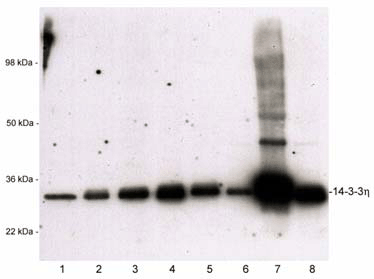Replaces Prod. #: ALX-215-023
Product Details
| Alternative Name: | KCIP-1, Protein kinase C inhibitor protein 1, Protein AS1 |
| |
| Host: | Rabbit |
| |
| Immunogen: | Acetylated N-terminal domain of 14-3-3 eta. |
| |
| UniProt ID: | Q04917 (human) |
| |
| Species reactivity: | Human, Mouse, Rat
Bovine, Chicken, Sheep
|
| |
| Applications: | IHC, WB
|
| |
| Recommended Dilutions/Conditions: | Immunohistochemistry (1:600)
Western Blot (1:3,000)
Suggested dilutions/conditions may not be available for all applications.
Optimal conditions must be determined individually for each application. |
| |
| Blocking Peptide: | For Blocking peptide see Prod. No. BML-SP476.
|
| |
| Formulation: | Liquid. Neat serum containing sodium azide. |
| |
| Shipping: | Blue Ice |
| |
| Long Term Storage: | -20°C |
| |
| Regulatory Status: | RUO - Research Use Only |
| |

Western blot of 14-3-3 eta in 1) HeLa S100 (C), 2) HeLa whole cell, 3) Jurkat, 4) MDCK, 5) A431, 6) MDF-7, 7) rat brain, and 8) PC12 cell lysates. Developed with anti-14-3-3 eta antibody BML-SA476 (1:3’000) and HRP/ECL.
Please mouse over
General Literature References
Novel brain 14-3-3 interacting proteins involved in neurodegenerative disease.: S. Mackie & A. Aitken; FEBS J.
272, 4202 (2005),
Abstract;
Unchanged survival rates of 14-3-3gamma knockout mice after inoculation with pathological prion protein.: P. Steinacker et al.; Mol. Cell Biol.
25, 1339 (2005),
Abstract;
Interaction of Akt-phosphorylated ataxin-1 with 14-3-3 mediates neurodegeneration in spinocerebellar ataxia type 1.: H.K. Chen et al.; Cell
113, 457 (2003),
Abstract;
Mammalian and yeast 14-3-3 isoforms form distinct patterns of dimers in vivo.: M. Chaudhri; Biochem. Biophys. Res. Commun.
300, 679 (2003),
Abstract;
Functional specificity in 14-3-3 isoform interactions through dimer formation and phosphorylation. Chromosome location of mammalian isoforms and variants.: A. Aitken; Plant Mol. Biol.
50, 993 (2002),
Abstract;
Immunolocalisation of 14-3-3 isoforms in normal and scrapie-infected murine brain.: H.C. Baxter et al.; Neuroscience
109, 5 (2002),
Abstract;
Isoform pattern of 14-3-3 proteins in the cerebrospinal fluid of patients with Creutzfeldt-Jakob disease.: J. Wiltfang et al.; J. Neurochem.
73, 2485 (1999),
Abstract;
14-3-3 inhibits the Dictyostelium myosin II heavy-chain-specific protein kinase C activity by a direct interaction: identification of the 14-3-3 binding domain.: M. Matto-Yelin et al.; Mol. Biol. Cell.
8, 1889 (1997),
Abstract;
The structural basis for 14-3-3:phosphopeptide binding specificity: M.B. Yaffe et al.; Cell
91, 961 (1997),
Abstract;
Identification of 14-3-3 proteins in human platelets: effects of synthetic peptides on protein kinase C activation.: C.P. Wheeler-Jones et al.; Biochem. J.
315, 41 (1996),
Abstract;
Neurofibrillary tangles of Alzheimer's disease brains contain 14-3-3 proteins.: R. Layfield et al.; Neurosci. Lett.
209, 57 (1996),
Abstract;
14-3-3 alpha and delta are the phosphorylated forms of raf-activating 14-3-3 beta and zeta. In vivo stoichiometric phosphorylation in brain at a Ser-Pro-Glu-Lys MOTIF.: A. Aitken et al.; J. Biol. Chem.
270, 5706 (1995),
Abstract;
Expression and structural analysis of 14-3-3 proteins.: D.H. Jones et al.; J. Mol. Biol.
245, 375 (1995),
Abstract;
Isoforms of 14-3-3 protein can form homo- and heterodimers in vivo and in vitro: implications for function as adapter proteins.: D.H. Jones et al.; FEBS Lett
368, 55 (1995),
Abstract;
Purification of 14-3-3 protein and analysis of isoforms in chicken brain.: Y. Patel et al.; Biochim Biophys Acta
1222, 405 (1994),
Abstract;
Subcellular localisation of 14-3-3 isoforms in rat brain using specific antibodies.: H. Martin et al.; J. Neurochem.
63, 2259 (1994),
Abstract;
Antibodies against the major brain isoforms of 14-3-3 protein. An antibody specific for the N-acetylated amino-terminus of a protein.: H. Martin et al.; FEBS Lett.
331, 296 (1993),
Abstract;












